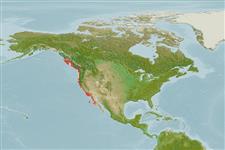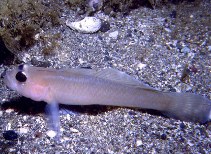Rhinogobiops nicholsii (Bean, 1882)
Blackeye goby
Waarneming toevoegen in Fish Watcher
| Native range | All suitable habitat | Point map | Year 2050 |

|
| This map was computer-generated and has not yet been reviewed. |
| Rhinogobiops nicholsii AquaMaps Data sources: GBIF OBIS |
Uploaden van uw Foto's en video's
Pictures | Google afbeeldingRhinogobiops nicholsii
Picture by Steele, M.A.
Pictures | Google afbeeldingRhinogobiops nicholsii
Picture by Steele, M.A.
Classificatie / Names Lokale namen | Synoniemen | Catalog of Fishes(Genus, Soort(en)) | ITIS | CoL | WoRMS | Cloffa
> Gobiiformes (Gobies) > Gobiidae (Gobies) > Gobiinae
Etymology: Rhinogobiops: Greek, rhinos = nose + Latin, gobius = gudgeon Greek, ops = similar to; nicholsii: Named after Capt. H.E. Nichols, U.S.N, its discoverer (Ref. 6885).
Eponymy: Captain Henry Ezra Nichols (d: 1899) was a US Navy officer at the Department of Alaska. [...] (Ref. 128868), visit book page.
More on author: Bean.
Etymology: Rhinogobiops: Greek, rhinos = nose + Latin, gobius = gudgeon Greek, ops = similar to; nicholsii: Named after Capt. H.E. Nichols, U.S.N, its discoverer (Ref. 6885).
Eponymy: Captain Henry Ezra Nichols (d: 1899) was a US Navy officer at the Department of Alaska. [...] (Ref. 128868), visit book page.
More on author: Bean.
Environment: milieu / climate zone / depth range / distribution range Ecologie
marien demersaal; diepte 0 - 106 m (Ref. 2850). Subtropical; 55°N - 27°N, 136°W - 114°W
Verspreiding Landen | FAO regio's | Ecosystemen | Voorkomen | Point map | Introducties | Faunafri
Eastern Pacific: Wales Island, northern British Columbia, Canada to Punta Rompiente, central Baja California, Mexico.
Grootte / Gewicht / Leeftijd
Maturity: Lm ? range ? - ? cm
Max length : 15.0 cm TL mannelijk / geslacht onbekend; (Ref. 2850); max. gerapporteerde leeftijd: 5 Jaren (Ref. 56049)
Max length : 15.0 cm TL mannelijk / geslacht onbekend; (Ref. 2850); max. gerapporteerde leeftijd: 5 Jaren (Ref. 56049)
Korte beschrijving Determinatiesleutels | Morfologie | Morfometrie
Dorsale stekels (totaal) : 5 - 7; Dorsale zachte stralen (totaal) : 12 - 14; Anale stekels: 0; Anale zachte stralen: 11 - 12. Caudal rounded.
Found usually in sandy areas near rocks. Occurs from intertidal areas to 106 m depth. Retreats to rocks or holes when approached. Young are found usually offshore among plankton. Oviparous (Ref. 56079). A protogynous hermaphrodite (Ref. 34256). Forms permanent harem groups composed of a single male and several smaller females (Ref. 55367). Eggs are guarded by the male (Ref. 56079).
Levenscyclus en paargedrag Maturiteit | Voortplanting | Paaien | Eieren | Fecunditeit | Larven
Nesting occurs from April-October. Male cleans spawning site under rock, then attracts female by rising from bottom to display his black pelvic disk. Male guards nest after female lays eggs. Protogynous (Ref. 13452, 35501). Sex reversal is completed in less than 5 months (Ref. 34185, 34256). A monandric species (Ref. 55367). Length at sex change = 6.9 cm TL (Ref. 55367). Also Ref. 103751.
Hoofdreferentie
Upload your references | Referenties | Coördinator | Medewerkers
Eschmeyer, W.N., E.S. Herald and H. Hammann, 1983. A field guide to Pacific coast fishes of North America. Boston (MA, USA): Houghton Mifflin Company. xii+336 p. (Ref. 2850)
CITES
Not Evaluated
Gevaar voor de mens
Harmless
Gebruik door de mens
Visserij: commercieel; Aquarium: Publieke aquaria
FAO - Publication: search | FishSource |
Meer informatie
Population dynamics
Groeiparameters
Max. ages / sizes
Length-weight rel.
Length-length rel.
Lengtefrequenties
Massaconversie
Rekrutering
Abundantie
Groeiparameters
Max. ages / sizes
Length-weight rel.
Length-length rel.
Lengtefrequenties
Massaconversie
Rekrutering
Abundantie
Life cycle
Voortplanting
Maturiteit
Maturity/Gills rel.
Fecunditeit
Paaien
Spawning aggregations
Eieren
Ontwikkeling van de eieren
Larven
Larvale populatiedynamiek
Voortplanting
Maturiteit
Maturity/Gills rel.
Fecunditeit
Paaien
Spawning aggregations
Eieren
Ontwikkeling van de eieren
Larven
Larvale populatiedynamiek
Anatomy
Kieuwoppervlak
Brain
Otolith
Kieuwoppervlak
Brain
Otolith
Physiology
Body composition
Nutrients
Zuurstofverbruik
Zwemtype
Zwemsnelheid
Visual pigments
Fish sound
Diseases & Parasites
Toxicity (LC50s)
Body composition
Nutrients
Zuurstofverbruik
Zwemtype
Zwemsnelheid
Visual pigments
Fish sound
Diseases & Parasites
Toxicity (LC50s)
Genetics
Genetica
Heterozygosity
Erfelijkheid
Genetica
Heterozygosity
Erfelijkheid
Human related
Aquaculture systems
Aquacultuurprofielen
Kweeklijnen
Ciguatera cases
Stamps, coins, misc.
Aquaculture systems
Aquacultuurprofielen
Kweeklijnen
Ciguatera cases
Stamps, coins, misc.
Tools
Bio-Quiz | E-boek | Veldgids | Lengtefrequentie Tool | Levenscyclus tool | Verspreidingskaart | Classification Tree
| Catch-MSY |
Speciale rapporten
Bekijk gegevens voor het houden in een aquarium | Bekijk Fact Sheets voor de soort | Bekijk Aquacultuur Fact Sheets
Download XML
Internetbronnen
AFORO (otoliths) | Aquatic Commons | BHL | Cloffa | BOLDSystems | Websites from users | Bekijk FishWatcher | CISTI | Catalog of Fishes: Genus, Soort(en) | DiscoverLife | ECOTOX | FAO - Publication: search | Faunafri | Fishipedia | Fishtrace | GenBank: genoom, nucleotide | GloBI | Google Books | Google Scholar | Google | IGFA World Record | MitoFish | Otolith Atlas of Taiwan Fishes | Publieke aquaria | PubMed | Reef Life Survey | Socotra Atlas | Tree of Life | Wikipedia: ga naar, zoek | World Records Freshwater Fishing | Zoological Record
Estimates based on models
Preferred temperature (Ref. 123201): 8.3 - 12.8, mean 9.8 °C (based on 66 cells).
Fylogenetische diversiteitsindex (Ref. 82804): PD50 = 1.0000 [Uniqueness, from 0.5 = low to 2.0 = high].
Bayesian length-weight: a=0.01023 (0.00477 - 0.02194), b=3.01 (2.83 - 3.19), in cm total length, based on LWR estimates for this (Sub)family-body shape (Ref. 93245).
Trofisch niveau (Ref. 69278): 3.4 ±0.58 se; based on food items.
Weerstandsvermogen (Ref. 120179): Gemiddeld, minimale populatieverdubbelingstijd 1,4-4,4 jaar (tmax=5).
Fishing Vulnerability (Ref. 59153): Low vulnerability (10 of 100).
Nutrients (Ref. 124155): Calcium = 162 [79, 343] mg/100g; Iron = 1.32 [0.70, 2.56] mg/100g; Protein = 18.5 [16.6, 20.1] %; Omega3 = 0.4 [0.2, 0.7] g/100g; Selenium = 21.9 [10.9, 43.4] μg/100g; VitaminA = 18.8 [5.8, 59.0] μg/100g; Zinc = 1.06 [0.73, 1.59] mg/100g (wet weight);




